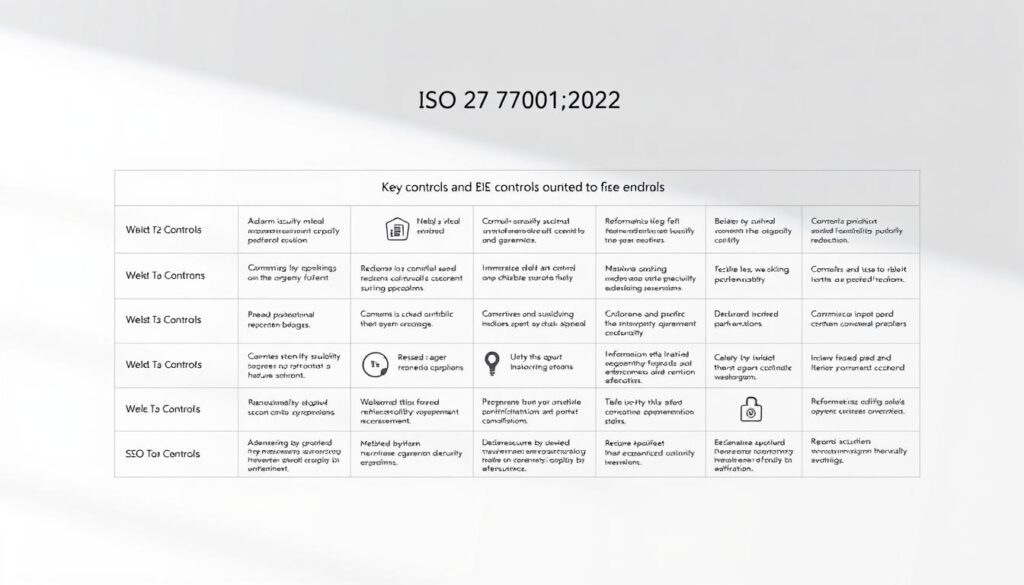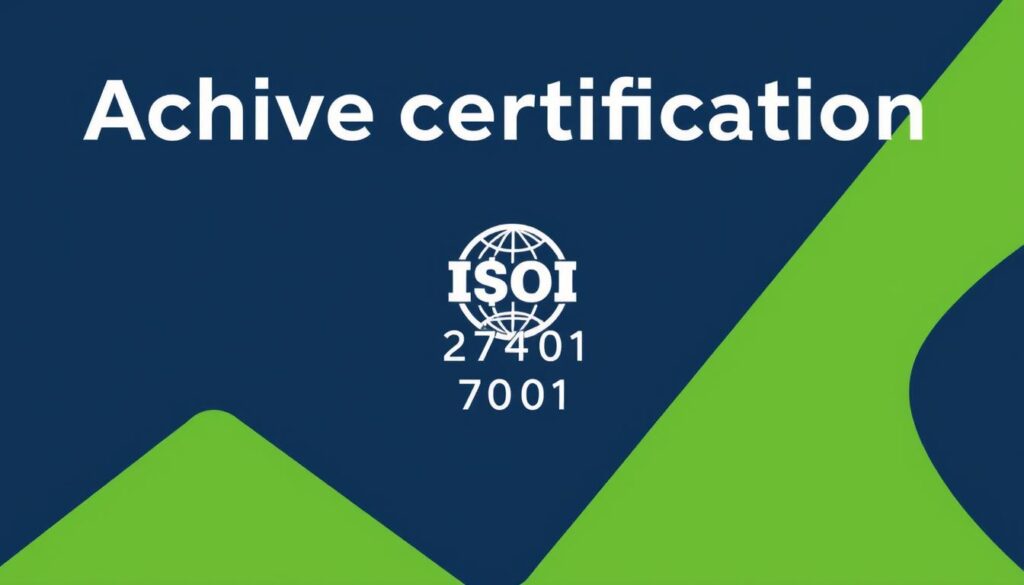Did you know that thousands of organizations worldwide have adopted the ISO/IEC 27001:2022 standard to strengthen their security posture and protect their valuable information assets?
This internationally recognized framework provides a systematic approach to managing sensitive company information, ensuring it remains secure through comprehensive risk management processes.
By adopting this standard, organizations can meet regulatory requirements and build trust with customers and partners. You’ll discover how ISO/IEC 27001:2022 can benefit your organization by providing guidance on establishing, implementing, and maintaining an effective information security management system.
Key Takeaways For Information security management :
- Understand the importance of ISO/IEC 27001:2022 for protecting information assets.
- Learn how the standard provides a systematic approach to managing sensitive company information.
- Discover the benefits of adopting the standard, including strengthened security posture and regulatory compliance.
- Gain insights into implementing an effective information security management system.
- Understand how the standard can help build trust with customers and partners.
What is ISO/IEC 27001:2022?
The latest iteration of ISO/IEC 27001, published in 2022, represents a significant milestone in the evolution of information security standards. As you explore this standard, it’s essential to understand its definition, purpose, and how it has evolved over time to address emerging information security challenges.
Definition and Purpose
ISO/IEC 27001:2022 is the international standard that specifies the requirements for an information security management system (ISMS). It provides a framework for organizations to manage and reduce the risk associated with the security of their information assets.
By adopting ISO/IEC 27001:2022, organizations can demonstrate their commitment to information security and comply with relevant legal and regulatory requirements. For more information on implementing an ISMS based on this standard, you can visit https://ucsiso.com/iso-iec-27001-information-security-management-systems/.
Evolution from Previous Versions
The journey of ISO/IEC 27001 began with its first publication in 2005, based on BS 7799 Part 2 from 1999. Since then, it has undergone significant revisions. The 2013 version adopted the High-Level Structure (HLS) to facilitate integration with other management systems. The latest 2022 version continues this evolution, featuring restructured security controls in Annex A that align with ISO/IEC 27002:2022, organizing controls into four themes.
This evolution reflects the changing landscape of information security threats and practices, with a greater emphasis on risk-based thinking and adaptability to emerging technologies and threats.
The Importance of Information Security Management Systems
As cyber threats continue to evolve, implementing a robust information security management system is crucial for organizations. The increasing frequency and sophistication of cyber-attacks have made it imperative for organizations to adopt a systematic approach to managing information security.
Growing Cyber Threats and Vulnerabilities
The threat landscape is constantly changing, with new vulnerabilities emerging regularly. Cyber-attacks can lead to significant financial losses, damage to reputation, and legal liabilities. Implementing the ISO/IEC 27001 standard helps reduce vulnerability to these threats by providing a framework that ensures information security across all aspects of an organization.
By adopting this standard, you can respond effectively to evolving security risks and ensure that your organization’s information assets remain protected. This includes safeguarding financial statements, intellectual property, employee data, and information entrusted by third parties.
Protecting Organizational Information Assets
Information has become one of the most valuable assets for modern organizations. Protecting this asset requires a comprehensive security management approach. An effective information security management system addresses the three fundamental principles of information security: confidentiality, integrity, and availability.
- Ensuring that information is accessible only to authorized individuals.
- Maintaining the accuracy and completeness of information.
- Ensuring that information is accessible when needed.
By implementing such a system, organizations can protect not only their own data but also the information entrusted to them by customers, partners, and other stakeholders. This helps in maintaining business continuity and preventing disruptions caused by security incidents.
Key Components of ISO/IEC 27001:2022 – Information security management systems

As you explore the ISO/IEC 27001:2022 standard, understanding its key components is crucial for implementing an effective Information Security Management System (ISMS). This standard is designed to help organizations protect their information assets through a robust framework.
Core Structure and Requirements
The core structure of ISO/IEC 27001:2022 is centered around the Plan-Do-Check-Act (PDCA) cycle, which is fundamental to its management framework. This cycle ensures continuous improvement in your organization’s information security posture. The standard outlines specific requirements for establishing, implementing, maintaining, and continually improving an ISMS.
Risk Assessment and Management Framework
A critical component of ISO/IEC 27001:2022 is the risk assessment and management process. You are required to identify, assess, and mitigate risks to your organization’s information assets. This involves understanding your organization’s context and the needs and expectations of interested parties. The standard provides a framework for managing risk, ensuring that you can make informed decisions about how to treat risks.
Annex A Controls Overview
security controls organized into four themes: Organizational controls, People controls, Physical controls, and Technological controls. These controls are detailed in ISO/IEC 27002:2022, which offers guidance on their implementation. You can select the controls that are relevant to your organization’s information security needs based on your risk assessment results.
- The controls cover a wide range of security aspects, from policies and human resource security to cryptography and incident management.
- You are not required to implement all controls; instead, you must document your decisions in the Statement of Applicability (SoA).
- This approach allows your organization to tailor its ISMS to its specific needs and risks.
Benefits of Implementing ISO/IEC 27001:2022

Achieving ISO/IEC 27001:2022 certification is a strategic move that brings numerous benefits to your organization. By adopting this international standard, you not only enhance your information security management system but also gain a competitive edge in the market.
Enhanced Information Security Posture
One of the primary benefits of implementing ISO/IEC 27001:2022 is the significant enhancement of your organization’s information security posture. Certification demonstrates your commitment to information security, and the rigorous assessment process ensures that your security practices are aligned with international standards. This leads to improved risk management and reduced vulnerabilities.
Regulatory Compliance and Business Advantages
ISO/IEC 27001:2022 certification also facilitates regulatory compliance and offers several business advantages. The certification process involves independent third-party validation, providing objective assurance that your organization meets recognized security standards. This can be a significant differentiator in business proposals and customer communications, setting you apart from competitors.
Building Customer and Stakeholder Trust
In today’s data-driven economy, customers and partners are increasingly concerned about how their information is protected. ISO/IEC 27001:2022 certification serves as a powerful trust signal, demonstrating your organization’s commitment to information security. The transparency inherent in the ISO/IEC 27001 framework helps build trust with regulators, investors, and other stakeholders by showcasing a systematic approach to managing information security risks.
The benefits of certification are multifaceted:
- Independent third-party validation of your security practices
- Enhanced trust with customers, partners, and stakeholders
- Improved risk management and reduced vulnerabilities
- Competitive advantage in marketing materials and customer communications
- Potential minimization of reputational damage in the event of a security incident
The ISO/IEC 27001:2022 Certification Process

The process of obtaining ISO/IEC 27001:2022 certification involves several critical steps that organizations must carefully follow. To start, you need to understand the requirements and prepare your information security management system (ISMS) accordingly.
Preparation and Documentation Requirements
Preparation is key to a successful certification audit. You must develop and implement an ISMS that meets the ISO/IEC 27001:2022 standard’s requirements. This involves creating necessary documentation, including policies, procedures, and records. Your ISMS should be designed to manage information security risks and ensure the confidentiality, integrity, and availability of your organization’s information assets.
The Three-Stage Audit Process
The certification process involves a three-stage audit conducted by a certification body. The first stage reviews your ISMS documentation, the second stage assesses the implementation and effectiveness of your ISMS, and the third stage confirms that your ISMS continues to operate effectively over time. Each stage is crucial for ensuring that your ISMS meets the standard’s requirements.
Maintaining Your Certification
Maintaining ISO/IEC 27001:2022 certification requires ongoing commitment and continuous improvement of your ISMS. This involves regular surveillance audits conducted by your certification body, typically annually, to verify continued compliance. You must also conduct internal audits and management reviews to ensure your ISMS remains effective and aligned with the standard’s requirements.
Key aspects of maintaining certification include:
- Conducting regular internal audits to identify and address nonconformities.
- Performing management reviews to evaluate the ISMS’s effectiveness and make strategic decisions.
- Undergoing surveillance audits annually to verify continued compliance.
- Completing a recertification audit every three years to renew your certification.
Implementing ISO/IEC 27001:2022 in Your Organization
To effectively implement ISO/IEC 27001:2022, you must first establish a clear understanding of your organization’s context and information security requirements. This involves understanding the internal and external issues that may impact your information security management system (ISMS).
Establishing the ISMS Scope and Context
Defining the scope of your ISMS is crucial. It involves identifying the boundaries and applicability of the ISMS within your organization. You should consider the internal and external context, including the organization’s structure, activities, and stakeholders.
Leadership Commitment and Policy Development
Leadership commitment is vital for the successful implementation of ISO/IEC 27001:2022. Top management must demonstrate their commitment by establishing an information security policy that aligns with the organization’s overall strategy. This policy should be communicated to all relevant stakeholders.
Risk Assessment and Treatment Planning
Conducting a thorough risk assessment is foundational to an effective ISMS. You need to systematically identify your information assets, potential threats, vulnerabilities, and the impacts that could occur. Your risk assessment methodology should be clearly defined and documented.
- Identify and evaluate risks based on your organization’s risk criteria.
- Develop a risk treatment plan that outlines how you will address significant risks through mitigation, transfer, avoidance, or acceptance.
- Create a Statement of Applicability (SoA) that documents the controls you’ve implemented, excluded, and the justification for these decisions.
Risk treatment is an ongoing process. As your organization, threats, and technologies evolve, you must regularly reassess risks and update your controls and treatment plans accordingly.
ISO/IEC 27001:2022 and Related Standards
The latest version of ISO/IEC 27001 has been designed to be compatible with other management system standards, facilitating integration. This compatibility is a significant advantage for organizations that aim to implement a comprehensive management system that addresses multiple aspects of their operations, including quality, environmental management, and occupational health and safety, alongside information security.
The ISO/IEC 27000 Family
ISO/IEC 27001 is part of the ISO/IEC 27000 family, a series of standards related to information security management systems (ISMS). This family provides a comprehensive framework for organizations to manage their information security risks effectively. The standards within this family cover various aspects of ISMS, from the requirements for implementing an ISMS (ISO/IEC 27001) to guidelines for implementing such a system.
Key components of the ISO/IEC 27000 family include:
- ISO/IEC 27000: Overview and vocabulary
- ISO/IEC 27001: Requirements for an ISMS
- ISO/IEC 27002: Code of practice for information security controls
Integration with Other Management Systems
One of the significant benefits of ISO/IEC 27001:2022 is its ability to be integrated with other management system standards. By following the same High-Level Structure (HLS) as other ISO management system standards (such as ISO 9001 for quality management and ISO 14001 for environmental management), organizations can streamline their management processes. This integration allows for reduced documentation duplication and a more cohesive approach to organizational governance and risk management.
By integrating ISO/IEC 27001 with other management systems, organizations can:
- Conduct combined internal audits and management reviews
- Implement a unified management system that addresses multiple standards
- Enhance overall organizational efficiency and effectiveness
Conclusion For Information security management :
ISO/IEC 27001:2022 is more than just a standard; it’s a comprehensive framework for securing your organization’s valuable information assets. By adopting this standard, you’re not just enhancing your information security management systems, you’re also demonstrating your commitment to best practices in information security.
The benefits of implementing ISO/IEC 27001:2022 are multifaceted, including enhanced security posture, regulatory compliance, and increased stakeholder trust. Whether you’re just starting your information security journey or looking to formalize existing practices, this standard offers a flexible, risk-based approach tailored to organizations of any size or industry.
By achieving ISO/IEC 27001:2022 certification, you’re making a strategic business investment that protects your organization’s most critical assets and supports your long-term objectives. This journey of continuous improvement helps your organization stay ahead of emerging threats while showcasing your dedication to information security.
FAQ For Information security management :
What is the primary purpose of implementing an Information Security Management System (ISMS) based on ISO/IEC 27001:2022?
The primary purpose is to protect your organization’s information assets from various threats and vulnerabilities, ensuring the confidentiality, integrity, and availability of sensitive data.
How does ISO/IEC 27001:2022 help in managing risk?
It provides a structured risk assessment and management framework that enables you to identify, assess, and mitigate potential risks to your organization’s information assets.
What are the benefits of achieving ISO/IEC 27001:2022 certification?
Achieving certification demonstrates your organization’s commitment to information security best practices, enhancing customer and stakeholder trust, and potentially leading to business advantages and regulatory compliance.
How often should we review and update our ISMS to maintain certification?
You should regularly review and update your ISMS to ensure it remains effective and aligned with the standard’s requirements, with a certification audit typically conducted annually.
Can ISO/IEC 27001:2022 be integrated with other management systems?
Yes, the standard is designed to be compatible with other management systems, such as quality and environmental management systems, allowing for a more streamlined and efficient management process.
What is the role of Annex A controls in ISO/IEC 27001:2022?
Annex A provides a comprehensive set of controls that you can implement to mitigate identified risks and ensure the security of your organization’s information assets.
How does ISO/IEC 27001:2022 support regulatory compliance?
By implementing the standard, you can demonstrate compliance with various regulatory requirements related to information security, reducing the risk of non-compliance and associated penalties.
Read more about Information security management :
How Long Does it Take to Get a Cybersecurity Degree? Learn More
